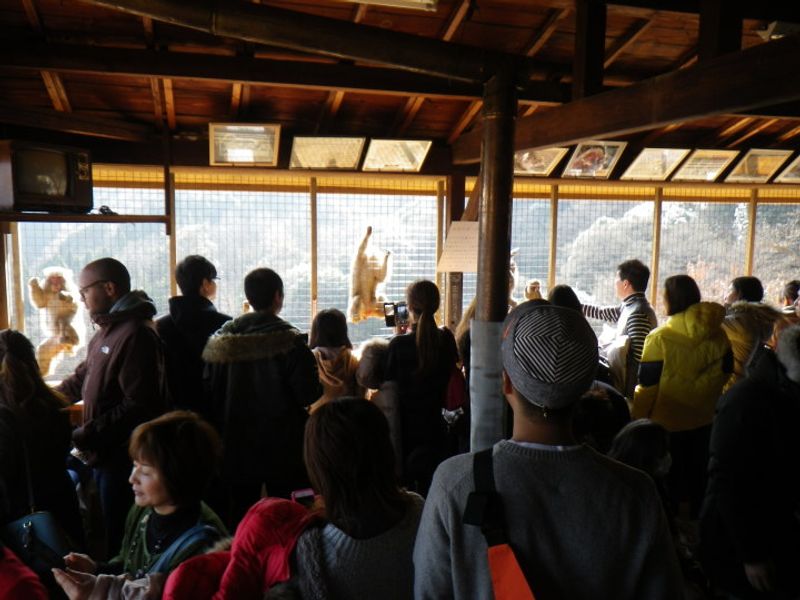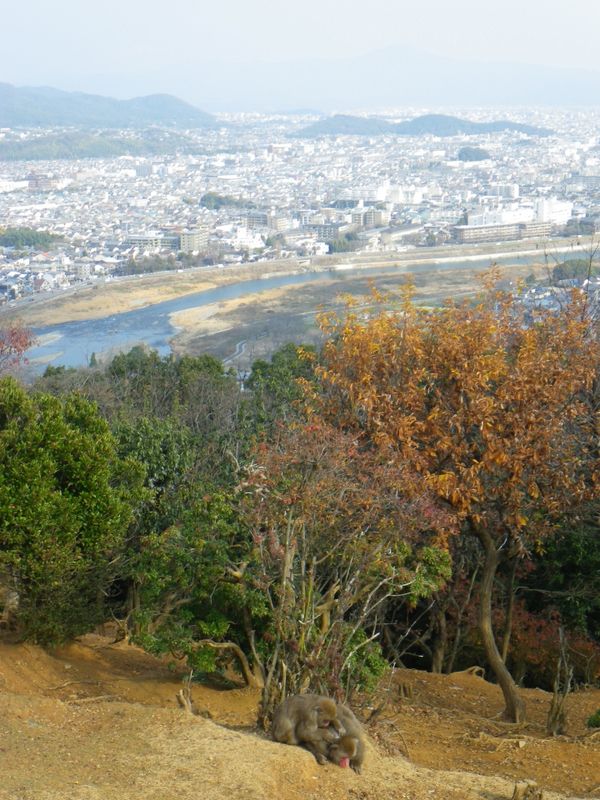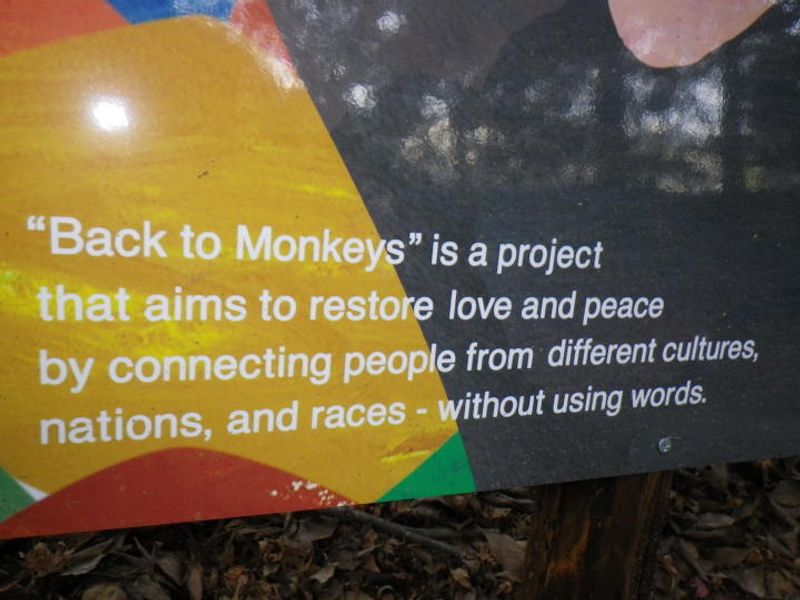Jan 12, 2016
Monkeys in Kyoto?!
 When my husband suggested we visit a monkey park on the second day of the New Year, my first thought was were we going to see more people than monkeys? Was the park going to be as crowded as the shrine we visited the day before, or as crowded as the department stores my in-laws are so fond of visiting during the first week of the new year? We just started "year of the monkey" and New Year's is the biggest holiday of the year in Japan ... My husband assured me that Japanese people are not so interested in seeing the monkeys and really, how many overseas visitors in the dead of winter, take time out from historical sightseeing to check out the local monkeys?
When my husband suggested we visit a monkey park on the second day of the New Year, my first thought was were we going to see more people than monkeys? Was the park going to be as crowded as the shrine we visited the day before, or as crowded as the department stores my in-laws are so fond of visiting during the first week of the new year? We just started "year of the monkey" and New Year's is the biggest holiday of the year in Japan ... My husband assured me that Japanese people are not so interested in seeing the monkeys and really, how many overseas visitors in the dead of winter, take time out from historical sightseeing to check out the local monkeys?We took a train bound for Arashiyama from Katsura Station. Most passengers seemed to be tourists, about half nationals and half not. We got seats. The air was crisp, but it was pleasant in the the sun. I would forgo this trip if it were snowing, raining, windy or below 10 degrees.
At Arashiyama, I spotted some cyclists,and gazed longingly at the rent-a-cycle shop in front of the station, however my husband thought my son too young; he had visions of the little guy on a big bicycle weaving in and out of traffic and bumping into the backs of old ladies' legs.
We sauntered along the riverside promenade for about 15 minutes, crossed the street at the famous bridge, and found a signboard indicating that we were approaching the ticket gate of "Iwatayama Monkey Park." Tickets, ice-cream and monkey related souvenirs are sold from a modest building in the woods.
We paid a modest fee and started up the narrow, mountain path. Signs warned us not to look monkeys in the eye, not to squat, and not to feed or approach them. We huffed and puffed and near the top, took off our jackets. Did the parents who left their strollers at the bottom realize what they were in for ? We encountered some of them carrying their young children. This park may not be worth it if you are: tired, lazy, hungry, whiny, have weak lungs or legs, or your child is under six. Luckily, we had had a huge breakfast, were well-rested and our six-year old was keen. We learned about the monkeys on the way up from fun quizzes on wooden signboards in both English and Japanese.
Just before reaching the feeding hut, we passed a see-saw, slide and short zip-line. I wasn't sure if the playground was for the visitors or for the monkeys. Nobody was using it. Later, before descending, we noticed some kids riding the zip line. Our son enjoyed his turn.
At the top, there were couples, families, and solo travelers, in high heels, with dreadlocks, in spandex pants, and all wielding cameras, all musing out loud about the monkeys in different accents and tongues, all trying for National Geographic-quality photos; monkeys were moving around freely, eating, sitting in trees, grooming and quarreling. The monkeys disregarded the people beyond the feeding area. The backdrop to this scene is a panoramic view of Kyoto City.
We entered the feeding hut, where we could chose to feed a Y100 bag of peanuts or Y100 bag of apple bits to the monkeys through wire mesh that separates inside from outside. A reverse zoo! My son chose the apple bits. Pink human fingers and monkey fingers stretched across the mesh to meet. Monkeys scrambled on the tin roof above us. I liked the monkey babies best.
Outside, a staff member with a megaphone intermittently reminded visitors not to get too close. It was not so much a case of humans approaching monkeys, as it was of monkeys walking by, one step behind humans. It's a wonder a tourist didn't trip on a monkey, taking a step back to get a wider angle shot. The monkeys sometimes screamed about some injustice or other, but they seemed to avoid getting stepped on despite their small stature and close proximity.
We descended on a separate trail, which converged with the original trail near the bottom. Just as we were about to exit, I noticed a sign that encouraged those descending to give high fives to those going up the mountain, in an effort to promote fellowship and peace within our own species. Nice.


Housewife, mother, paid English conversation partner, editor, writer, Japanese student, yoga practitioner, Forest Therapy practitioner, former equestrian, current urban cyclist/explorer, fan of international exchange offices, community centres, libraries and Japan Post, ecologist, social activist, festival goer, outdoors enthusiast, adventurer, animal lover, healthy-living advocate, seeker, net addict (in remission?!).



2 Comments
KamaT
on Jan 12
Don't look the monkeys in the eye. Ha! I like that. Sounds like a tough climb. I've always enjoyed the presence of high heeled shoes in the most unlikely of places in Japan; the beach, hiking trails, Mt. Fuji ... You've got the appreciate the commitment (or denounce whatever pressure it is that makes people wear them in these kind of situations). Looks like you get a pretty good view from up there, anyway. Worth the effort to get there?
maynestacy
on Jan 14
Definitely worth the 15-20 minute hike up if the weather is agreeable! Yes, high heels -- they are bad for the feet but good for looks I suppose, and perhaps for developing balance and finesse. Definitely good for practicing "gaman" or perseverance. Brand-name expensive bags can be seen in the most unlikely of places too. What is it with Japanese people's obsession with bags? Well that's yet another post. Tomuu, we'd make a great writing team - so many ideas coming up.